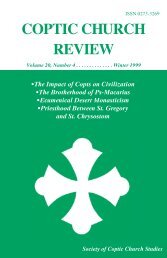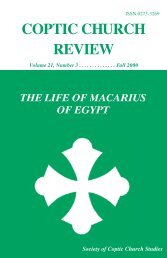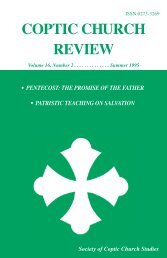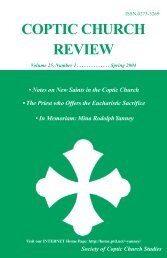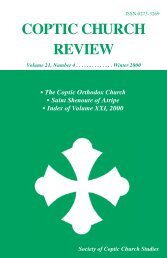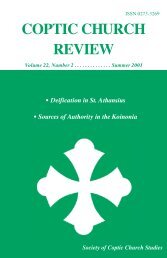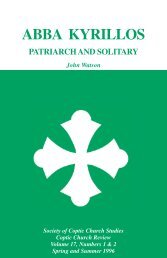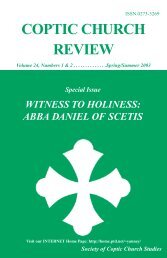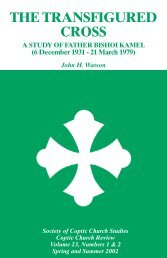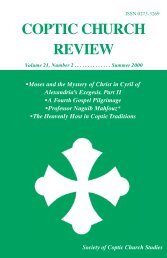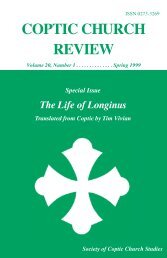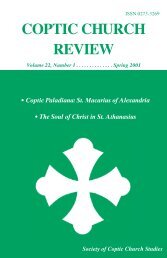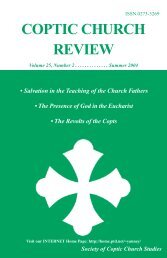2004 Fall.Vol25.#3.pdf - Coptic Church Review
2004 Fall.Vol25.#3.pdf - Coptic Church Review
2004 Fall.Vol25.#3.pdf - Coptic Church Review
You also want an ePaper? Increase the reach of your titles
YUMPU automatically turns print PDFs into web optimized ePapers that Google loves.
84 <strong>Fall</strong> <strong>2004</strong> • <strong>Coptic</strong> <strong>Church</strong> <strong>Review</strong> - Volume 25, Number 3<br />
In his Commentary on the Gospel of St. Luke, St. Cyril also says,<br />
It was fitting therefore, for him to be in us both divinely by the<br />
Holy Spirit, and also to be mingled with our bodies by his holy<br />
flesh and precious blood; which things also we possess as a lifegiving<br />
Eucharist, in the form of bread and wine. For lest we<br />
should be terrified by seeing flesh and blood placed upon the<br />
holy tables of our churches, God, humbling himself to our infirmities,<br />
infuses into the things set before us the power of life, and<br />
transforms them into the efficacy of his flesh, that we may have<br />
them for a life-giving participation and that the body of him who<br />
is the life may be found in us as a life–producing seed. And do<br />
not doubt that this is true, since He himself plainly says, this is<br />
my Body: This is my Blood: but rather receive in faith the<br />
Savior’s word: for He, being the Truth, cannot lie. 22<br />
Conclusion<br />
It is evident that although the ancient <strong>Church</strong> Fathers have insisted on the biblical<br />
truth of the real presence of Christ in the Eucharist and that the bread and<br />
wine change into his Body and Blood, yet none of them tried to explain how this<br />
change takes place, nor did they anticipate any of the Latin terms that the<br />
Scholastic theologians of the Middle Ages used later. St. John of Damascus (8th<br />
century), the last of the Eastern <strong>Church</strong> Fathers, gives a simple answer, “If you are<br />
asking, how does this happen, it is enough to know that it is through the Holy<br />
Spirit.”<br />
The spirit of the early <strong>Church</strong> Fathers is still alive in the <strong>Church</strong> today, not<br />
only in their writings that have been studied in the last decades of the twentieth<br />
century, but also in the Orthodox liturgies, most of which are from the earliest centuries.<br />
Here are two examples from <strong>Coptic</strong> liturgies:<br />
1. The Fraction Prayers. These prayers of the priest while he breaks the host are<br />
characteristic of the <strong>Coptic</strong> liturgy. The prayer used during the feasts of the<br />
angelic hosts starts with a declaration that reflects the teaching of St. James of<br />
Serugh with which this chapter begins:<br />
Today on this table is present with us Emmanuel our Lord,<br />
The Lamb of God who carries the sins of the whole world,<br />
Who sits upon the throne of his glory,<br />
And before whom stand all the heavenly hosts.<br />
22 Cyril of Alexandria, Commentary on the Gospel of St. Luke (on Chapter 22: 17-22. Translated by<br />
Payne Smith. Studion Publishers, 1983: 571.




